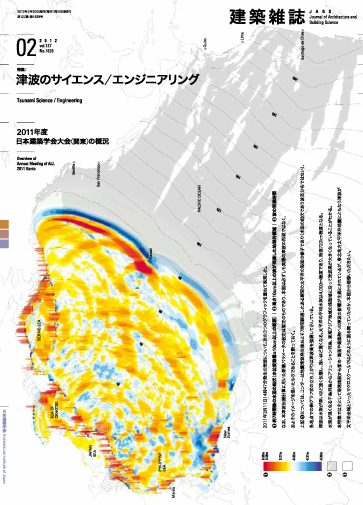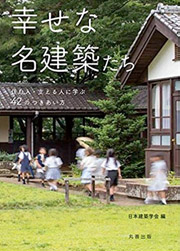本文PDFの閲覧につきましては、こちらでご確認ください。

2012-2月号 FEBRUARY
特集= 津波のサイエンス/エンジニアリング
Tsunami Science/Engineering
特集前言 津波から建築はどう見えるか
津波をテーマとする本号では、土木分野の専門家諸氏に多数ご登場いただいた。『建築雑誌』としては異例である。
津波については、土木分野に膨大な蓄積がある一方で、建築分野では研究面でも実務面でも対応が大幅に立ち遅れてきた。このこと自体、考えてみるべき問題ではないか。
従来、建築学にとって災害とは何よりもまず地震であった。佐野利器が耐震構造の研究を国家的使命と自覚して以来、この分野が有能な研究者・実務家を輩出し、法制化や技術開発を通して社会的にも大きな影響力を持ってきたことはよく知られるとおりである。
建築物は所有で切り分けられた土地のそれぞれに個別に建ち上がり、しかもその大部分は民間事業である。とりわけ日本はこの傾向が顕著だ。私たちの眼は、それゆえ、地表面上の「点」(建物)とその集積(都市や集落)という見方を宿命付けられてきたように見える。建築の耐震・震動制御もまた基本的にはこうした前提的枠組みの上に成り立ってきたのではないか。
私たちの眼にとって3.11の津波が衝撃的であったのは、その被害の甚大さだけでなく、むしろ津波が上記の枠組みを撹拌する異様な怪物のように映ったためかもしれない。津波は海からまず海岸という「線」に到達し、それを乗り越えると性質を変えつつ「面」を洗い、反射し、重なり、浮き上がらせた建物を瓦礫や自動車とともに運んで互いに衝突させる。
土木学の分野ではこうした複雑きわまりない現象に対して、主として「線」、つまり防波堤・防潮堤などを工学技術の対象とする。これら構造物の建設はほぼすべてが公共事業であり、それが背後の都市や集落を守る。むろん限界はあるが、建築学は津波の問題をこの「線」に預けてきたということか。明治・昭和の三陸大津波の悲惨な経験は、建築学にはなぜ大きなインパクトを刻み込まなかったのか。
津波は、いろいろな意味で建築学の眼のありようを問い直す。むろん、地域社会の側に立ってみれば、学問の垣根などに意味はない。実際、3.11後、土木分野との連携が欠かせぬことをすぐさま悟った建築専門家は少なくないだろう。また、一朝にして津波を知った私たちの眼には国土イメージも様変わりしたが、三陸沿岸はじめ地道な取組みを続けてきた地方から見れば、私たちの地図が偏っていたということである。
本特集では、土木分野における津波の科学/工学の水準を学びつつ、建築学がそれをどう受け止め、いかに連携して社会に向き合うべきかを考えようとした。東日本大震災の復興計画は出揃ってきたが、まだまだ判断を迫られる課題は多いだろう。予想される東海・東南海・南海地震への対策も含めて、多様な国土に人が住みつくための工学的要件をいかに社会が理解していくかは、今世紀の大きな課題となるだろう。
巻頭座談会では、「海の土木」の分野で津波防災の最前線にかかわってきた宮本卓次郎、高橋重雄、柴山知也の3氏と、建築分野で海洋に携わってきた濱本卓司氏に、本特集の大きな見取図を描いていただいた。津波防災の歴史的経緯、現状の認識と今後の課題について、多岐にわたる重要な論点が闊達に提示されており、建築への示唆的なメッセージも多い。
つづく各論は、篠原雅尚、越村俊一、富田孝史、下迫健一郎、増田光一の各氏にお願いした。海溝型地震の予知・予測と観測技術、津波伝播のシミュレーションと津波被害予測、港湾構造物の設計、漂流物の問題と建築物への影響、といったテーマが論じられている。
結びの座談会では、重村力、中埜良昭、畔柳昭雄、伊澤岬の4氏をお招きし、主に建築や集落・都市の計画・デザインの立場から津波防災をどう考えていけばよいか、その可能性を広く展望していただいた。
ところで、本号のタイトルでは「サイエンス」と「エンジニアリング」の間に、スラッシュを入れた。工学技術は、科学の延長ではないからだ。高度な計算技術を手にしながらも、不確実性、限界、壊れ方、復元力、コスト、コミュニケーションといった問題系と無関係に合理性を主張できないのが工学技術である。その独自の意義を回復することが、技術者の倫理かもしれない。巻頭座談会はじめ、本号の各記事もこうした問いかけである。
本号編集担当は、居駒知樹(日本大学)・田村和夫(千葉工業大学)・加藤研一(小堀鐸二研究所)である。
会誌編集委員会(青井哲人)
[目次]
| 000 | 連載 再建への意志:図面のなかの都市復興 ハワイ島ヒロの津波復興計画/村尾修 |
| 002 | 連載 東日本大震災|連続ルポ1|動き出す被災地 自治体間連携による仮設住宅支援員配置事業─大船渡市と北上市による新しい連携のかたち/菊池広人 |
| 004 | 連載 東日本大震災|連続ルポ2|仮すまいの姿 新潟県湯沢町による広域避難者受け入れ「赤ちゃんプロジェクト」の展開/澤田雅浩 |
特集 津波のサイエンス/エンジニアリング
| 006 | 特集前言 津波から建築はどう見えるか/青井哲人 |
| 008 | 座談会 津波をめぐる工学の今─津波防災の専門家は東日本大震災をどう見るか 高橋重雄 × 濱本卓司 × 柴山知也 × 宮本卓次郎 |
| 013 | 海溝型地震発生予測研究と海域観測技術/篠原雅尚 |
| 015 | 東北地方太平洋沖地震津波災害の教訓と地域の復興に向けての課題/越村俊一 |
| 018 | 港湾における津波波力と津波計算/富田孝史 + 下迫健一郎 |
| 020 | 建築物への津波荷重と漂流物影響の予測/増田光一 |
| 023 | 座談会 津波防災と計画・設計をつなぐ 重村力 × 伊澤岬 × 畔柳昭雄 × 中埜良昭 |
| 027 | 編集後記 居駒知樹 |
| 027 | 次号予告 2012年3月号|特集:東日本大震災1周年「リジリエント・ソサエティー」 |
| 028 | 特集を読んで 2011年12月号|特集:国・人・土のデザインII 不安定な大地とどうつながるか 寄り添う/横張真 風土のケアとレジリエンス/斎藤環 |
| 029 | 連載 建築の争点 モダニズム建築って何?/大田省一 |
| 030 | 連載 ケンチク脳の育て方 フィールドワーク/饗庭伸 + 初田香成 |
| 031 | 連載 ケンチク脳の活かし方 ロボットにより新産業をクリエイトする/松井龍哉 |
| 032 | 連載 地域いろいろ・多様な日本 生活館という文脈 北海道・新ひだか町/森傑 |
Preface to the Special Issue: Architecture In Light of Tsunami
In this issue on the theme of tsunami many civil engineering experts appear, which is unusual for the Journal of Architecture and Building Science.
While the field of civil engineering has long addressed tsunami as a major concern, the field of architecture has largely been late in treating this issue, both in study and in practice - which must be a considerable issue in itself, don't you think?
Conventionally, earthquakes have been the foremost disaster for architecture. And since Toshikata Sano first realized that the study of earthquake-proof construction should be a national mission, it has been recognized that this field has produced capable researchers and practical minds, and has greatly influenced society through legal and technical developments.
Buildings stand individually on their own plots of land, which are cut up as property, and almost all of this is privately owned. This tendency is noticeable especially in Japan. Therefore, it seems we are fated to have the aspect of "points" (buildings) and their "collection" (cities or villages). Architecture's earthquake-proofing/shake-control is also composed on that assumed framework, I think.
The March 11 tsunami was so shocking maybe not entirely because of the enormous damage but because it also seemed an odd monster that mixed up the above-mentioned framework. Coming ashore, a tsunami first reaches the "line" called the beach, crosses that line, changes quality as it washes out the "surface," reflects, piles up, and carries uprooted buildings, together with debris and cars, all crashing into one another.
For such an extremely complicated phenomenon, civil engineering takes mainly "line" - breakwaters, seawalls, and so on - as the object of engineering. Most of these constructions are public projects that protect cities and villages behind the line. There is a limit, of course, but I wonder if architecture has left the issue of tsunami to the line. Why didn't the tragic experience of the Great Sanriku Tsunami in Meiji and Showa etch the big impact into architecture?
Tsunami ask again in various meanings what architecture's stance should be. Of course, from the community side the academic border is nonsense. In fact, there must be quite a few architecture experts who after March 11 immediately realized that there should be no lack of teamwork with civil engineering. And although our image of the land changed for those of us who so quickly understood tsunami, for regions such as the Sanriku coast, which have been steadily plugging away, it meant that our map had been biased.
In this special issue, while learning about the level of tsunami science/engineering in civil engineering, we try to understand how architecture accepts it and faces society in cooperation with it. Plans for recovery from the Great East Japan Earthquake are largely in place, but there must be a lot of issues still to decide. A big issue this century will be how society comprehends engineering requirements for living in various land areas, including provisions for predictable Tokai, Tonankai and Nankai earthquakes.
In the introductory conversation, Takujiro Miyamoto, Shigeo Takahashi, and Tomoya Shibayama, who have all been connected with the front line of tsunami disaster prevention in the field of "coastal engineering," and Takuji Hamamoto, who has been involved with the ocean in the field of architecture, drew the big plan for this special issue. The manifold important points of contention in the historical course of tsunami disaster prevention, in realizing the present condition, and in issues hereafter are all presented frankly, along with many suggestive messages for architecture.
We asked Masanao Shinohara, Shunichi Koshimura, Takashi Tomita, Kenichiro Shimosako, and Koichi Masuda for details, and they addressed themes such as the prevision and prediction of trench earthquakes and the techniques of observation, simulated tsunami-propagation and prediction of tsunami damage, plans for harbor construction, and problems of drifting debris and the impact on buildings.
We invited four people - Tsutomu Shigemura, Yoshiaki Nakano, Akio Kuroyanagi, and Misaki Izawa - to the closing conversation and asked them for a wide overview of how we might think about tsunami disaster prevention from the viewpoints of architecture or planning and design for villages and cities.
Incidentally, we put a slash (/) between science and engineering in the title of this issue because engineering is not an extension of science. It is engineering that despite having high calculation techniques in hand cannot insist on rationality irrespective of systems of problems such as uncertainty, limits, how things break, resilience, costs, and communication. Restoring this essential meaning of engineering might be engineers' ethics. The opening conversation and every article in this issue pose such questions.
This issue has been edited by Tomoki Ikoma (Nihon University), Kazuo Tamura (Chiba Institute of Technology), and Kenichi Kato (Kobori Research Complex Inc.).
Editorial Board (Akihito Aoi)
[contents]
| 000 | [Series] The Resolve to Rebuilding: City Reconstruction in Blueprint Urban Renewal Plan by Kaiko' o Project, 1965 / Osamu Murao |
| 002 | [Series] Great East Japan Earthquake Serial Report 1 Devastated Areas Have Just Started to Stir Project for the Arrangement of Temporary-Housing Supporters through Cooperation between Autonomies ─A New Case of Cooperation Involving Ofunato and Kitakami Cities / Hiroto Kikuchi |
| 004 | [Series] Great East Japan Earthquake Serial Report 2 Life in Temporary Housing Yuzawamachi, Niigata: Development of the "Baby Project" that Accepts Evacuees from a Wide Area / Masahiro Sawada |
Special Feature
Tsunami Science/Engineering
| 006 | [Preface to the Special Issue] Architecture In Light of Tsunami / Akihito Aoi |
| 008 | [Discussion] Engineering for Tsunami Now ─How Experts in Tsunami-Disaster Prevention See the Great East Japan Earthquake Shigeo Takahashi × Takuji Hamamoto ×Tomoya Shibayama × Takujiro Miyamoto |
| 013 | Research in Prediction for Earthquakes in Subduction Zone and Technology for Marine Geophysical Observation / Masanao Shinohara |
| 015 | Lessons from the 2011 Tohoku Earthquake Tsunami Disaster towards Tsunami-Resilient Community / Shunichi Koshimura |
| 018 | Tsunami Wave Force and Tsunami Calculation in Harbors / Takashi Tomita + Kenichiro Shimosako |
| 020 | Prediction of Tsunami Loads and the Impact of Drifting Debris on Buildings / Koichi Masuda |
| 023 | [Discussion] Tying Tsunami-Disaster Prevention to Planning & Design Tsutomu Shigemura × Misaki Izawa × Akio Kuroyanagi × Yoshiaki Nakano |
| 027 | [Editor's Postscripts] Tomoki Ikoma |
| 027 | [Previews of Coming Issues] 2012, March|The first anniversary of the 3.11 East Japan Earthquake Disaster: Resilient Society |
| 028 | [Reviews of Previous Issue] 2011, December|Designing Nation, People, and Land: Vol. II How to Connect with an Unpredictable Earth Being Together / Makoto Yokohari Care of Natural Features and Resilience / Tamaki Saito |
| 029 | [Series] Issues in Architecture What is Modernism Architecture? / Shoichi Ota |
| 030 | [Series] Cultivating Versatile Architects Fieldwork / Shin Aiba + Kosei Hatsuda |
| 031 | [Series] Architects Branch Out Creating New Industries by Using Robots / Tatsuya Matsui |
| 032 | [Series] Local Identities: Diverse Japan The Concept of Seikatsukan in Shinhidaka-cho, Hokkaido / Suguru Mori |




 『幸せな名建築たち 住む人・支える人に学ぶ42のつきあい方』
『幸せな名建築たち 住む人・支える人に学ぶ42のつきあい方』





